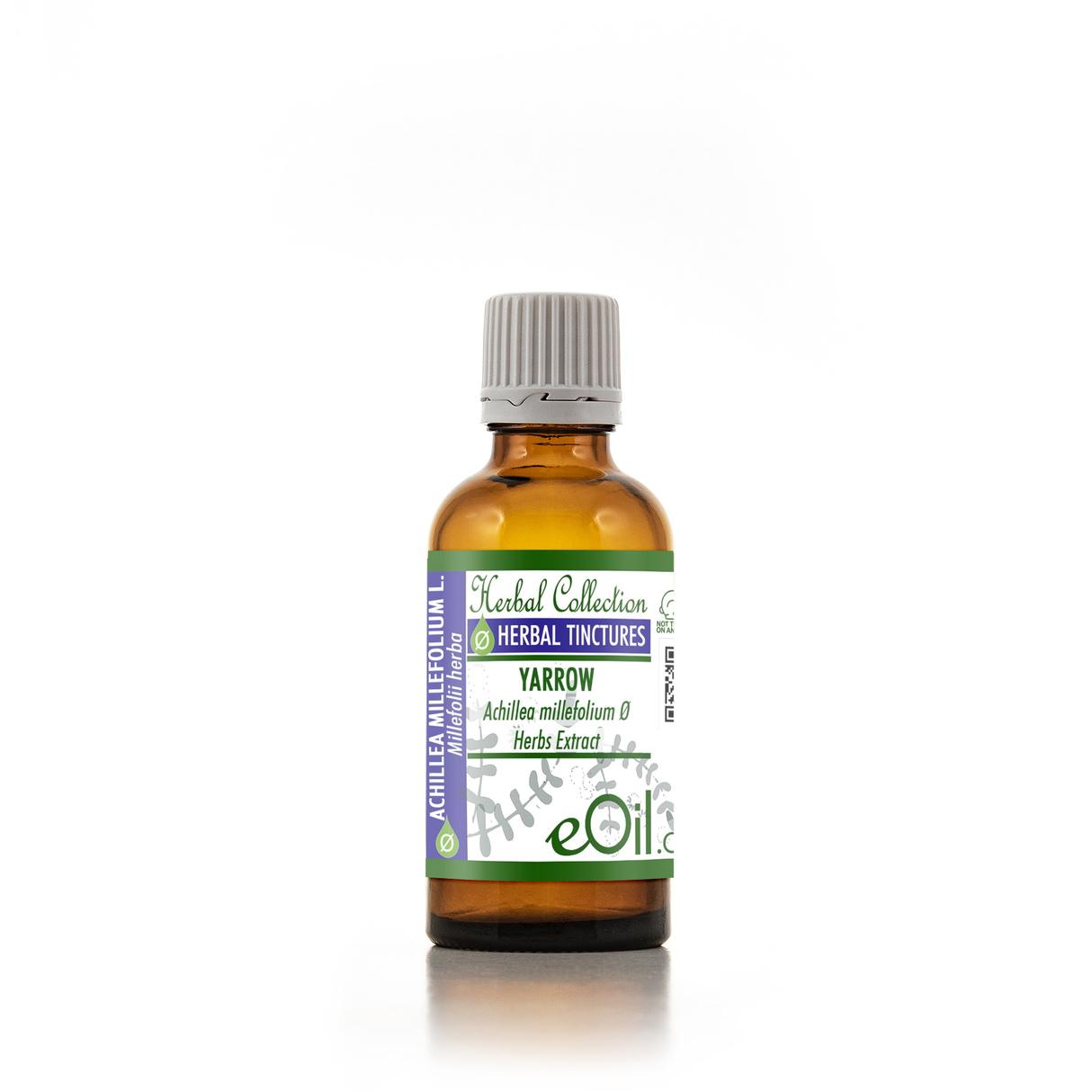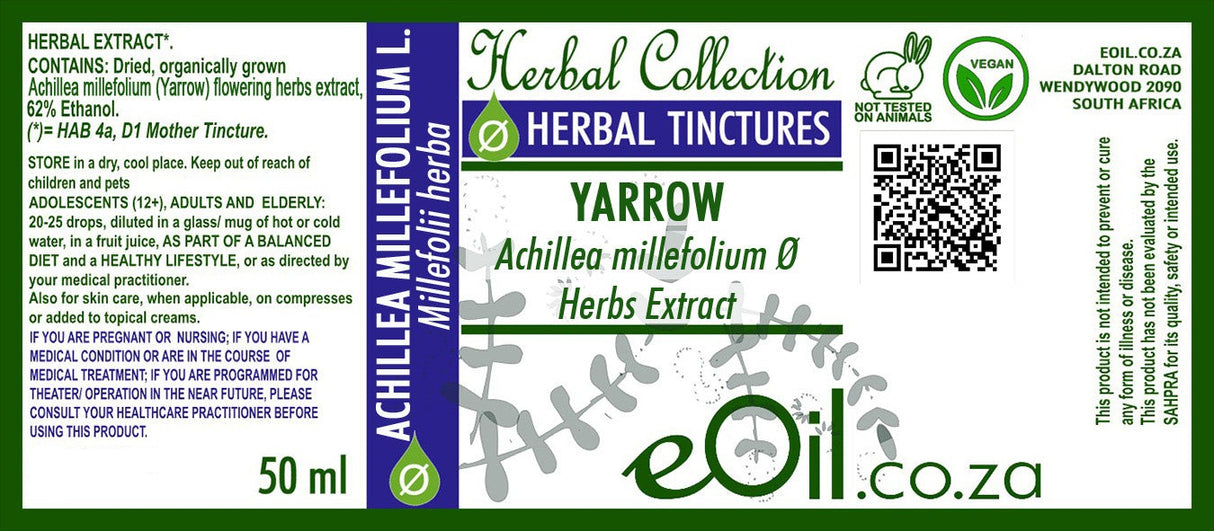Yarrow - Liquid Herbal Extract
Yarrow - Liquid Herbal Extract - 50 ML is backordered and will ship as soon as it is back in stock.
Description
Description
Understanding Mother Tinctures & Glycerines
Yarrow Liquid Herbal Extract tincture is made from Achillea millefolium, a plant known for its natural botanical compounds and traditional uses.
This extract is valued for its gentle, astringent qualities and is commonly added to daily wellness routines for broad support of digestion and general vitality.
Suitable for adults and ethically sourced, it contains no added fillers or artificial ingredients.
TRADITIONALLY USED FOR
Yarrow (Achillea millefolium) Liquid Herbal Extract Tincture
The wild meadow healer for bleeding, cycles, digestion, and calm—herbal first-aid in a potent, pure plant drop.
Key Benefits
- Astringent and Wound Care: Yarrow has long been prized as a natural astringent to help stop minor bleeding (cuts, nosebleeds), support tissue healing, and manage bruising.
- Menstrual & Hormonal Balance: Used traditionally to ease heavy menstrual flow, regulate cycles, relieve cramps, and support hormonal harmony.
- Digestive Comfort: Eases indigestion, bloating, and cramps by calming gut spasms and supporting healthy bile flow.
- Anti-inflammatory & Fever: Contains flavonoids and volatile oils for soothing inflammation, mild fever, and immune discomfort (“cooling” herb).
- First Aid Kit Essential: Topical (diluted) or internal use for minor injuries, period comfort, or digestive upsets.
Dosage & Directions
- Adults: 1–2 ml (about 20–40 drops) in water/juice, up to 3x daily as needed for cycles, digestion, or first aid.
- Topical: Dilute and dab on cuts/bruises as a wash or compress.
- Children (6+): Half adult dose, under practitioner direction.
- Not for pregnancy (may stimulate uterus) or with allergy to Asteraceae plants.
Cautions & Contraindications
- Generally well-tolerated, though possible allergy in sensitive users (especially if allergic to ragweed/chamomile/daisy family).
- Not for use during pregnancy or with active bleeding/clotting disorders.
- Discontinue if rash, severe GI upset, or allergy occurs.
Storage
- Store sealed, below 25°C, away from sunlight and children’s reach.
Yarrow Tincture Recap Table
| Product Type | Main Benefits | Dosage & Use | Best For | Not For / Cautions |
|---|---|---|---|---|
| Tincture | Astringent, cycles, wound healing, digestive, anti-inflammatory | 1–2 ml (20–40 drops), up to 3x daily | Period support, first aid, digestive ease | Pregnancy, Asteraceae allergy, kids <6, med caution |
INFORMATION
Yarrow (Achillea millefolium) Tincture
Identification
Common Name: Yarrow
Latin Name: Achillea millefolium
Family: Asteraceae
INCI Name: ACHILLEA MILLEFOLIUM EXTRACT
CAS Number: 84082-83-7
EC Number: 282-030-6
Description
Yarrow (Achillea millefolium) is a flowering perennial herb native to temperate regions of the Northern Hemisphere.
It grows up to 1 meter tall and has finely divided feathery leaves and clusters of small white or pink flowers. Yarrow has been used medicinally for centuries across many cultures.
Yarrow tincture is made by soaking the aerial parts (leaves, stems, and flowers) of the yarrow plant in alcohol to extract its beneficial compounds.
The resulting liquid is a concentrated herbal preparation.
Traditional Uses
Yarrow has a long history of traditional medicinal use for various purposes:
- Treating wounds and stopping bleeding
- Reducing fevers
- Easing digestive issues
- Alleviating menstrual problems
- Lowering blood pressure
- Improving circulation
- Reducing inflammation
- Supporting liver and gallbladder health
- Relieving colds and flu symptoms
- Promoting sweating
Modern Research
Some scientific studies have found evidence to support certain traditional uses of yarrow:
- Anti-inflammatory and analgesic effects
- Antimicrobial properties against certain bacteria and fungi
- Potential to reduce blood pressure and improve circulation
- Possible benefits for digestive issues like ulcers and IBS
- Antispasmodic effects that may help with menstrual cramps
However, more research is still needed to conclusively prove many of the traditional uses. Consult a healthcare provider before using yarrow medicinally.
How to Use
Yarrow tincture can be used in several ways:
- Take 20-40 drops in water, 2-3 times daily
- Add 10-20 drops to tea or other beverages
- Apply topically diluted in water for wound cleansing
- Use in aromatherapy massage blends (5-10 drops per ounce of carrier oil)
Start with a lower dose and gradually increase as needed. Do not exceed recommended amounts.
Cautions
- Avoid use if pregnant or breastfeeding
- May interact with blood thinners and medications for high blood pressure
- Can cause skin irritation in some people when applied topically
- May increase photosensitivity
- Discontinue use if any adverse reactions occur
- Not recommended for children under 12 without medical supervision
- Do not use if allergic to plants in the Asteraceae family
Storage
Store yarrow tincture in a cool, dark place away from direct sunlight. Keep tightly sealed when not in use. Properly stored, it should remain potent for 2-3 years.
Always consult a qualified herbalist or healthcare provider before using yarrow tincture medicinally, especially if you have any health conditions or take medications.
This information is for educational purposes only and is not intended to diagnose, treat, cure, or prevent any disease.
CAUTION
Store in a cool, dry place, away from light. Keep tightly closed, away from the reach of Children and pets.
Do not exceed the daily dose.
This product is not intended to prevent or cure any form of illness or disease.
If you are pregnant or nursing ; If you have a medical condition or are in the course of medical treatment ; If you are programmed for theater/operation in the near future, please consult your healthcare practitioner before using this product.
This product cannot replace a varied and balanced diet and a healthy lifestyle.
This product has not been evaluated by the SAHPRA for its quality, safety or intended use.

Yarrow - Liquid Herbal Extract - 50 ML is backordered and will ship as soon as it is back in stock.





